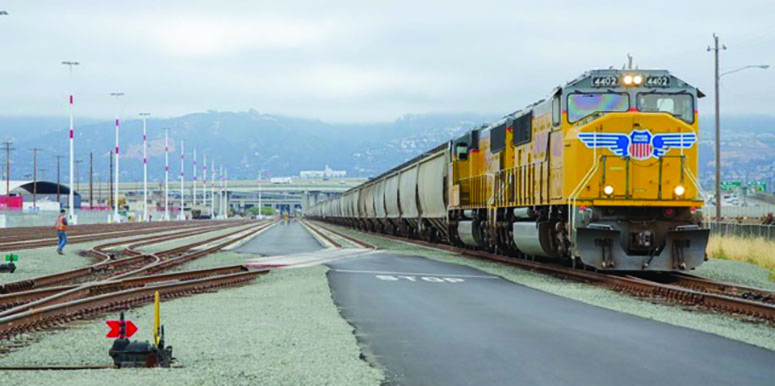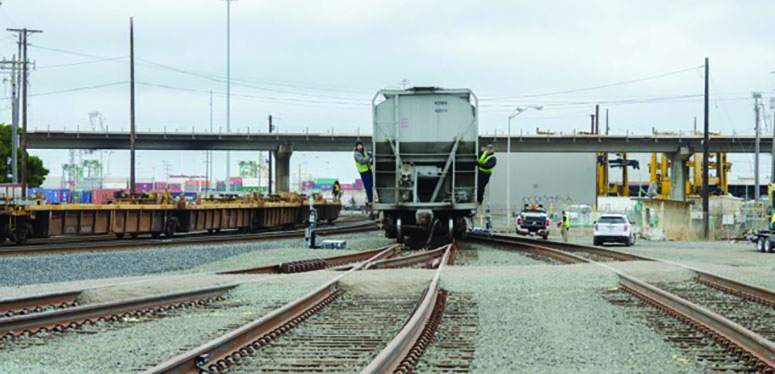The opening last month of a $100 million near-dock rail facility at the Port of Oakland allows the port to compete for a share of American exports that originate outside the Bay Area and typically travel to West Coast ports via rail.

The first train to pull into the Port of Oakland’s new rail yard was carrying 100 cars of cargo that was originally intended to depart for Asia from a Canadian seaport. Photo by Port of Oakland
By Bill Picture
Published: August, 2016
The opening last month of a $100 million near-dock rail facility at the Port of Oakland allows the port to compete for a share of American exports that originate outside the Bay Area and typically travel to West Coast ports via rail.
Without its own rail yard, the Port of Oakland had previously been out of the running to receive such cargo, much of which is bound for markets in Asia. As a result, manufacturers had to send the trains carrying their goods to rail-friendly ports in Los Angeles, Long Beach, Seattle, Canada or Mexico. Most often, the distance from the origin to one of these other ports was greater than the distance to Oakland, so routing the cargo through the Bay Area is a shorter, quicker and more environmentally friendly trip.
The first train to pull into the Port of Oakland’s new rail yard on July 7 was carrying 100 cars of livestock feed from the Midwest—feed that was originally intended to depart for Asia from a Canadian seaport. Shipping from Oakland instead is estimated to have shaved 200-plus miles off the trip from manufacturer to port. This spared the environment of the extra diesel emissions, and it also saved money. “When it comes to moving goods, time is money,” said port spokesperson Robert Bernardo.
Trains versus trucks
Rail remains the preferred mode of transportation for manufacturers moving large volumes of goods (like grains or other agricultural products) long distances to a port for loading onto oceangoing vessels. The reason rail prevails over trucks is simple—rail is more cost-effective for these volumes of goods. To move the same volume by truck would require significantly more loads. For example, each of the 100 rail cars that pulled into the Port of Oakland last month was carrying the equivalent of 3.5 40-foot freight containers, the kind typically seen being pulled by trucks.
“So to move that same load by truck would result in more vehicles on the highways, and more pollution,” said Bernardo. “Rail transport is definitely more environmentally friendly; and anytime you can help shorten the distance that goods have to travel, that’s a good thing for the environment regardless of the mode of transportation. But for us, less trucks on the roads is a big win.”
West Oakland has been plagued by poor air quality for years. And while port-related emissions are only partially to blame for this—the bigger culprit is the tens of thousands of vehicles traveling on nearby freeways each day—Bernardo believes every effort should be made to encourage manufacturers to consider greener means of transporting goods when possible.
According to a study by the National Association of Railroads, freight trains are four times more fuel efficient than trucks, so moving freight by rail would reduce greenhouse gas emissions by 75 percent.
The promise of a cleaner conscience is likely not enough to persuade those manufacturers who find trucking more convenient to give rail a go, but the promise of a quicker trip to port will at least pique the interest of some, particularly now that Oakland’s rail yard makes it a viable jumping-off point for rail cargo destined for Asia.
“These days, it’s all about how fast you can get cargo from the Midwest to Asia,” Bernardo said. “The quicker you can get the product to port, onto a ship and on its way, the better.”
It’s important to note that a good amount of the Asia-bound goods arriving at West Coast ports via rail comes from within California. There’s a growing demand for agricultural products from the Central Valley and Salinas Valley. Until now, these goods had to travel much farther to reach the nearest rail-friendly port.
Just the beginning
The new near-dock rail facility is part of a larger plan to enhance the Port of Oakland’s “intermodal” capability—that is, the ability for cargo to travel via multiple modes of transportation with a minimal amount of handling at transfer points. In most cases, this means truck to rail to ship. “That’s what makes a port truly competitive,” Bernardo said.
The rail yard itself, which broke ground in April 2013, was phase one of that plan. It consists of five manifest yard tracks and eight support yard tracks. Manifest yards receive inbound rail cars. Support yards are used for short term storage. In total, the new rail facility contains 39,000 linear feet of track.
Phase two of the plan is the construction of on-site warehouses and distribution centers, including refrigerated facilities that will allow for more perishable items to pass through the Port of Oakland. Once built, these warehouses and distribution centers will be occupied by port tenants, generating income for the port and creating scores of local jobs. Phase two is expected to be completed by spring 2018.
“And once phase two is up and running, we’ll be a global seaport logistics complex,” Bernardo said. “Then we’ll be super competitive.”
Phase one construction created about 500 jobs. By the time the port has fully realized its dream of being a seaport logistics complex, roughly 12,000 jobs will have been created.
“These are all things that I heard about when I first started working at the port,” Bernardo said. “Fast forward 14 years, and it’s actually happening. The major transformation that we’ve been talking about and planning for years is happening right now. It’s a very exciting time for the port.”

Freight trains are four times more fuel efficient than trucks, so moving freight by rail instead of trucks would reduce greenhouse gas emissions by 75 percent. Photo by Port of Oakland

